Booth Surname Ancestry ResultsOur indexes 1000-1999 include entries for the spelling 'booth'. In the period you have requested, we have the following 2339 records (displaying 1381 to 1390): Single Surname Subscription | | | Buying all 2,339 results of this search individually would cost £13,874.00. But you can have free access to all 2,339 records for a year, to view, to save and print, for £100. Save £13,774.00. More... |
These sample scans are from the original record. You will get scans of the full pages or articles where the surname you searched for has been found. Your web browser may prevent the sample windows from opening; in this case please change your browser settings to allow pop-up windows from this site.  Inhabitants of Newington in Surrey
(1851) Inhabitants of Newington in Surrey
(1851)
The 1851 census return for St Mary Newington, Surrey, registration district: St Peter Walworth sub-district: enumeration district 13: described as: "All that Part of the Parish of St. Mary Newington, which Comprises The West side of Burdett St., North side of Walworth Common to Portland St., East side of Portland St. to Clandon St., Clandon St. to Ewhurst St. (both sides), Including Guildford St. (both sides), John St. & Waterloo St. from Portland St. to Burdett St. (both sides), and St. Peter St. (both sides)". This area lay in the ecclesiastical district of St Peter Walworth, and in the borough of Lambeth. HO 107/1567. The addresses listed in the actual returns are 20 to 34 Burdett Street; 1 to 5, 8 to 14 and 19 (Saint) John Street; 1 to 5 St Peters Gardens (including White Cottage); 1 to 3 Lime Cottages; 1 to 11 Waterloo Street; 1 to 6 Frederick Place; 1 to 10 Peter Street; 1 to 10 Saint Peters Place' 2and 5 and 6 Waterloo Place; 1 to 7 Saint James Place; 1 to 12 and 115 to 121 Portland Street; 1 to 7 Adelaide Place, Portland Street; 1 to 5 Bath Place, Portland Street; 1 to 13 and 122 to 129 Guildford Street; and 1 to 15 Clandon Street (including Kings Head beerhouse).BOOTH. Cost: £4.00.  | Sample scan, click to enlarge

|  Inhabitants of Newington in Surrey
(1851) Inhabitants of Newington in Surrey
(1851)
The 1851 census return for St Mary Newington, Surrey, registration district: St Peter Walworth sub-district: enumeration district 7: described as: "All that Part of the Parish of St. Mary Newington, which Comprises Grosvenor Park (North & South) Includings Huts on Common, South Terrace, South side of Grosvenor St., and West side of Walworth Road to Parish boundary. Boundary Lane & Bolingbroke Row on the East side of Walworth Road to the Turnpike". HO 107/1567. This area lay in the ecclesiastical district of St Peter Walworth, and in the borough of Lambeth. The addresses listed in the actual returns are 1 to 44 Grosvenor Park North; Oliver Cottage; 1 to 4 Grosvenor Park Terrace; Red Garden Cottage, Lorrimore Common; 1 and 2 Lorrimore Common; Temperance Cottage, Windmill Lane; 5 to 38 Grosvenor Park South; 1 to 13 South Terrace, Grosvenor Park; Gardeners Cottage; 4 to 12 (including Lupton Cottage, 5) and 21 to 23 Grosvenor Street South; 1 to 4 White Cottage, Grosvenor Street; 6 to 18 Grosvenor Place, Walworth Road; 1 to 3 Bolingbroke Cottage, Boundary Row; Pilgrim Cottage, 21 Boundary Row; 1 to 3 Pilgrim Place, Boundary Row; 4 Vine Cottage; Omnibus(s) Yard; 5, Milk House, Boundary Row; 1 to 4 Elizabeth Place, Boundary Row; 1 to 26 Bolingbroke Row, Walworth; and Gurneys Stables.BOOTH. Cost: £4.00.  | Sample scan, click to enlarge

|  Inhabitants of Southwark in Surrey
(1851) Inhabitants of Southwark in Surrey
(1851)
The 1851 census return for St George the Martyr, Southwark, registration district: London Road sub-district: enumeration district 17: described as: "Charles Street (both sides) & House back of No 4 - Charles Place - South side of Westminster Road commencing at Catholic Chapel & including Princess Place, Asylum Buildings, Lee's Place & Hatfield Pl to the Crown inclusive - Lambeth Road to the Catholic Chapel & both sides of Joiner Street." This area lay in the parish of St George the Martyr, Southwark. The addresses listed in the actual returns are 1 to 29 Charles Street, 1 to 4 Charles Place, The Joiners Arms, 1 to 3 Joiners Place, 1 to 15 and 19 to 34 Joiner Street, St Georges Catholic Chapel, 1 to 5 Princess Place, 1 to 4 Asylum Buildings, 1 to 9 Hatfield Place, St Georges Circus (Crown Tavern), 1 to 7 Lees Place and 1 to 24 Lambeth Road.BOOTH. Cost: £4.00.  | Sample scan, click to enlarge

| Insolvents imprisoned for debt in England and Wales
(1851)
Perry's Bankrupt and Insolvent Gazette, issued monthly, included brief notices of insolvents' estates surrendered to assignees. Each entry gives the surname and christian name of the insolvent, trade and address, followed by the name of the prison. This is the index to the names of the insolvents, from the issues from January to December 1851.BOOTH. Cost: £6.00.  | Sample scan, click to enlarge

| Insolvents in England and Wales
(1851)
Perry's Bankrupt and Insolvent Gazette, issued monthly, included lists of insolvencies and stages in the process whereby the insolvents petitioned for release from debtors' prison. The insolvent is generally referred to by name (surname first), address and trade. This is the index to the names of the insolvents, from the issues from January to December 1851.BOOTH. Cost: £6.00.  | Sample scan, click to enlarge
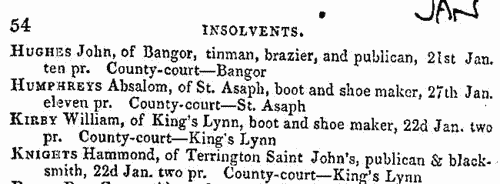
| Masters of Merchantmen and Shippers
(1851)
The London Mercantile Journal and Colonial Advocate, a weekly newspaper, published a report entitled Ships Entered Outwards, listing vessels registered with customs in the Port of London as preparing to leave for abroad. Under each day's heading each entry gives, first, the main port of destination; then the name of the ship; then the surname of the captain; nationality of the ship (e. g., B for British, D for Dutch, &c.); tonnage; the dock (e. g., W I D for West India Dock); and the name of the shipper or agent. These are the returns for December 1851. (The sample scan is from February)BOOTH. Cost: £6.00.  | Sample scan, click to enlarge

| Pupil Teachers in Cheshire: Boys
(1851)
The Committee of Council on Education awarded annual grants for the training and support of pupil teachers and stipendiary monitors in schools in England, Wales, Scotland, the Isle of Man and the Channel Islands. Pupil teachers started training between the ages of 13 and 15, and 'must not be subject to any bodily infirmity likely to impair their usefulness as Pupil Teachers, such as scrofula, fits, asthma, deafness, great imperfections in the sight or voice, the loss of an eye from constitutional disease, or the loss of an arm or leg, or the permanent disability of either arm or leg, curvature of the spine, or a hereditary tendency to insanity'.
They also had to obtain certificates from the managers of the school (and their clergyman, in the case of Church of England schools) as to their moral character and that of their family; good conduct; punctuality, diligence, obedience, and attention to duty; and attentiveness to their religious duties.
This detailed statement in the annual report of the committee for the year ending 31 October 1851 lists schools by county, giving:
1. Name and Denomination of School, with these abbreviations - B, British and Foreign School Society; F. C., Free Church of Scotland; H. C., Home and Colonial School Society; N., National Society, or connected with the Church of England; R. C., Roman Catholic Poor-School Committee; Wesn., Wesleyan Methodist.
2. Annual grants conditionally awarded by the committee in augmentation of teachers' salaries, and in stipends to apprentices, and gratuities to teachers.
3. Month in which annual examination was to be held.
4. Names of apprentices, giving surname and initials, and year of apprenticeship. Stipendiary monitors are indicated by (S. M.).BOOTH. Cost: £6.00.  | Sample scan, click to enlarge
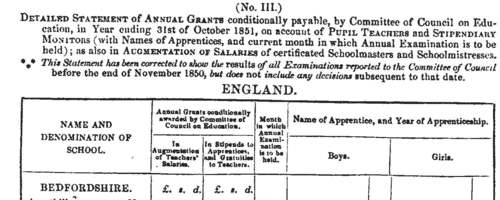
| Pupil Teachers in Lancashire: Boys
(1851)
The Committee of Council on Education awarded annual grants for the training and support of pupil teachers and stipendiary monitors in schools in England, Wales, Scotland, the Isle of Man and the Channel Islands. Pupil teachers started training between the ages of 13 and 15, and 'must not be subject to any bodily infirmity likely to impair their usefulness as Pupil Teachers, such as scrofula, fits, asthma, deafness, great imperfections in the sight or voice, the loss of an eye from constitutional disease, or the loss of an arm or leg, or the permanent disability of either arm or leg, curvature of the spine, or a hereditary tendency to insanity'.
They also had to obtain certificates from the managers of the school (and their clergyman, in the case of Church of England schools) as to their moral character and that of their family; good conduct; punctuality, diligence, obedience, and attention to duty; and attentiveness to their religious duties.
This detailed statement in the annual report of the committee for the year ending 31 October 1851 lists schools by county, giving:
1. Name and Denomination of School, with these abbreviations - B, British and Foreign School Society; F. C., Free Church of Scotland; H. C., Home and Colonial School Society; N., National Society, or connected with the Church of England; R. C., Roman Catholic Poor-School Committee; Wesn., Wesleyan Methodist.
2. Annual grants conditionally awarded by the committee in augmentation of teachers' salaries, and in stipends to apprentices, and gratuities to teachers.
3. Month in which annual examination was to be held.
4. Names of apprentices, giving surname and initials, and year of apprenticeship. Stipendiary monitors are indicated by (S. M.).BOOTH. Cost: £6.00.  | Sample scan, click to enlarge
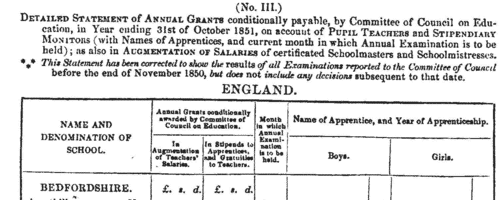
| Pupil Teachers in Lancashire: Girls
(1851)
The Committee of Council on Education awarded annual grants for the training and support of pupil teachers and stipendiary monitors in schools in England, Wales, Scotland, the Isle of Man and the Channel Islands. Pupil teachers started training between the ages of 13 and 15, and 'must not be subject to any bodily infirmity likely to impair their usefulness as Pupil Teachers, such as scrofula, fits, asthma, deafness, great imperfections in the sight or voice, the loss of an eye from constitutional disease, or the loss of an arm or leg, or the permanent disability of either arm or leg, curvature of the spine, or a hereditary tendency to insanity'.
They also had to obtain certificates from the managers of the school (and their clergyman, in the case of Church of England schools) as to their moral character and that of their family; good conduct; punctuality, diligence, obedience, and attention to duty; and attentiveness to their religious duties.
This detailed statement in the annual report of the committee for the year ending 31 October 1851 lists schools by county, giving:
1. Name and Denomination of School, with these abbreviations - B, British and Foreign School Society; F. C., Free Church of Scotland; H. C., Home and Colonial School Society; N., National Society, or connected with the Church of England; R. C., Roman Catholic Poor-School Committee; Wesn., Wesleyan Methodist.
2. Annual grants conditionally awarded by the committee in augmentation of teachers' salaries, and in stipends to apprentices, and gratuities to teachers.
3. Month in which annual examination was to be held.
4. Names of apprentices, giving surname and initials, and year of apprenticeship. Stipendiary monitors are indicated by (S. M.).BOOTH. Cost: £6.00.  | Sample scan, click to enlarge
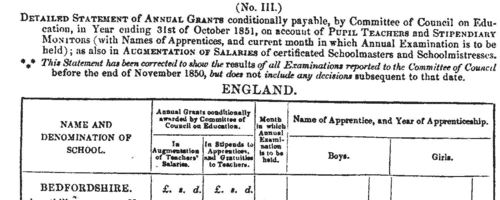
| Pupil Teachers in Yorkshire: Boys
(1851)
The Committee of Council on Education awarded annual grants for the training and support of pupil teachers and stipendiary monitors in schools in England, Wales, Scotland, the Isle of Man and the Channel Islands. Pupil teachers started training between the ages of 13 and 15, and 'must not be subject to any bodily infirmity likely to impair their usefulness as Pupil Teachers, such as scrofula, fits, asthma, deafness, great imperfections in the sight or voice, the loss of an eye from constitutional disease, or the loss of an arm or leg, or the permanent disability of either arm or leg, curvature of the spine, or a hereditary tendency to insanity'.
They also had to obtain certificates from the managers of the school (and their clergyman, in the case of Church of England schools) as to their moral character and that of their family; good conduct; punctuality, diligence, obedience, and attention to duty; and attentiveness to their religious duties.
This detailed statement in the annual report of the committee for the year ending 31 October 1851 lists schools by county, giving:
1. Name and Denomination of School, with these abbreviations - B, British and Foreign School Society; F. C., Free Church of Scotland; H. C., Home and Colonial School Society; N., National Society, or connected with the Church of England; R. C., Roman Catholic Poor-School Committee; Wesn., Wesleyan Methodist.
2. Annual grants conditionally awarded by the committee in augmentation of teachers' salaries, and in stipends to apprentices, and gratuities to teachers.
3. Month in which annual examination was to be held.
4. Names of apprentices, giving surname and initials, and year of apprenticeship. Stipendiary monitors are indicated by (S. M.).BOOTH. Cost: £6.00.  | Sample scan, click to enlarge
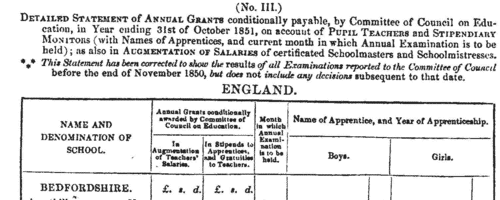
|
Research your ancestry, family history, genealogy and one-name study by direct access to original records and archives indexed by surname.
|













